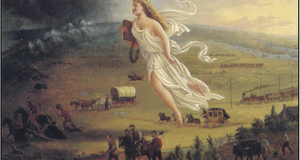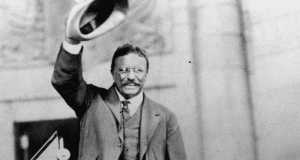Conspiracy: Did FDR Deceive the American People in a Push for War?McCollum, who had much experience in Japan and with the Japanese, believed tensions between the U.S and Japan would ultimately lead to war between the two nations.26 He composed a memorandum in the fall of 1940 outlining eight acts by the U.S that would provoke the Japanese into an act of aggression on the U.S. It was claimed that the memo was forwarded to FDR, whether it was read or not is still in question. It is speculation, supported by circumstantial evidence, that FDR put McCollum’s blueprint into effect the day after the document was received.27 The Memo lists eight major points that FDR is accused of using as his blueprint for war with Japan. For example, “F. KEEP THE MAIN STRENGHTH OF THE U.S FLEET NOW IN THE PACIFIC IN THE VICINITY OF THE HAWAIIAN ISLANDS.” 28 Ironically, in April of 1940, the majority of the fleet moved to the Hawaiian base for “training.”29 The Admiral for the Fleet at the time, Admiral Richardson, planned on returning the fleet to its west coast base at the conclusion of the training, yet Washington provided “specious explanations” preventing the fleet from returning, therefore remaining in the Hawaiian detachment.30 Even Admiral Richardson claimed that there was little sense in keeping the fleet in Hawaii.31 Within the year 1941, three of the eight points in McCullom’s document were executed. In observation his point E. in the memorandum, twenty-four naval submarines were sent to the Philippines, thus fulfilling sending two fleets of submarines to the orient request under McCullom’s memorandum.32 The Japanese embargo under point H. was executed in the summer if 1941.33These are just a few examples of McCollum’s memo’s execution and FDR’s involvement. If Roosevelt’s use of the blueprint was true and it was designed to provoke the Japanese, it was a success. Proof of the memo’s success was in the breaking of the diplomatic code (codename “Magic”), …the magic intercepts showed the Japanese diplomats expected war with American soon, the U.S. Army and Navy sent cautionary telegrams to U.S, military bases all over the world…”34 FDR’s provocation of the Japanese is merely half of the conspiracy; his knowledge of the attack is the other half. According to Admiral Stark’s (Chief of Naval Operations) document dated November 28, 1941; Washington knew an attack was coming, instructing that Japan commit “the first overt act.”35 The question now was not if Washington had prior knowledge, but how much knowledge; and now the question was where and when would this “overt act” take place? There are two matters at hand in regards to FDR’s knowledge of where and when the attack would occur: one, whether or not the Japanese operational code had been broken and two, if the Japanese broke radio silence during the journey across the Pacific.36 The Japanese have gone on record claiming that no ships broke radio silence that were involved in the Pearl Harbor attacks.37 It was stated that radio silence was broken from land bases in order to confuse U.S. intelligence. 38 It was confirmed during Truman’s administration that the Japanese diplomatic code, “magic” had been broken, yet there is controversy surrounding whether the operational code, named “the 5-Num code”, was broken, and it still remains questionable today.39 Also in doubt was if the incoming intelligence was kept up to date. If the current traffic was read at the time then knowledge of the attack would have been accessible. According to Stinnett, Lieutenant John Lietwiler broke the operational code and in November of 1941 claimed to be up to date on the incoming intelligence, ‘“We are reading enough current traffic…”’ admitted Lietwiler.40 Historian Stephen Budiansky, who debated Stinnett in 2003, claims that Stinnett’s sources are manipulated and hard to find, therefore invalid.41 According to Stinnett, Royal Ingersol, the Assistant Chief of Naval Operations, wrote a letter in 1940 that acknowledged the 5-Num arrangement had been “recovered.” FDR was on the receiving list the information that the 5-Num contained.42 That information, which included knowledge of “… a large build up in Japanese warships…” in designated areas, could have been considered an assertive act by the Japanese. It was decoded by CAST (the Philippine Naval cryptographic center) was placed into the hands of FDR.43 According to Stinnet then, claiming FDR held no knowledge of upcoming Japanese aggressions is erroneous. In regards to the current traffic that was read, it was confirmed that FDR received a message on December 6th from Japanese diplomats insisting trade be restored and interference in China be withdrawn. FDR knew at this point that if those requests were denied it meant war.44 He shared this concern with his aid Harry Hopkins, yet not with those who would have been the two most important reciprocates of this knowledge. 45 Admiral Kimmel and Short, the two commanding officers at the Pearl Harbor fleet, were notified that there would be an attack on the U.S. by the Japanese; there was no suggestion that it was going to be in Hawaii. Also, the two commanders were not informed of the “magic” codes or previous warnings at all; they had no information regarding the extent of importance of the warnings they received, “…the U.S government closely guarded the secret of magic. The translators put messages into locked briefcases and delivered them to top military and civilian officials. The Pearl Harbor commanders did not receive copies.”46 Some say the lack of information transmitted to the Admirals was intentional, that FDR purposefully set Pearl Harbor up for attack so he could obtain the people and Congress’s consent for war.47 Others claim that the two commanders were to blame, and they did in fact go on trial and were dismissed of all responsibility. However, can Short and Kimmel be held responsible when they were not properly informed of the danger they were about to face?48 Of course, with every conspiracy theory there are the anti-conspiracy theorists. Historians and specialists such as David Kennedy, Stephen Budiansky, and David Kahn claim there are manipulations and impossibilities regarding these conspiracies. There is much debate regarding the diplomatic codes and the operational codes. “Magic” did contain information about the Japanese pursuing war with the U.S. However, the military details would have been located in the operational codes which, depending on which historian one asks, were not broken until post Pearl Harbor.49 Even if operational codes had been broken, there was too much traffic of information coming in to be kept up to date by intelligence, according to historian David Kennedy. According to Burdiansky, the Grogan Log, which claimed to hear Japanese radio interference, was not the Japanese fleet but Japanese land bases. Budiansky also claims he has Naval documents claiming a month by month progression of code breaking and that the Japanese operational code was not broken until after 1942.50 These anti-conspiracy theorists claim that people like Stinnett have no sources to back up there accusations, although Stinnett devotes a full chapter of his book Day of Deceit, to the destroying of key documents directly before and after the trials following the event. Stinnett also accuses the government of retracting his Freedom of Information Act by removing many of the documents Stinnett not only had in his possession, but access to other files he had previously found after his publication Day of Deceit hit bookstores.51 The question of whether the government is trying to cover up the truth is one that’s been haunting people like Stinett for years. This obsession with who is to blame in regards to the bombings derives from the American ego. Why not just blame the Japanese, why does the enemy have to be internal? Historian David Kennedy states: “I think we were insulted…. that we could be taken on so successfully by a country that just two or three generations earlier had been essentially in a medieval stage…”52 Kennedy is not the only author or historian with this perspective. According to author George Victor, “… a popular stereotype pictured the Japanese as a puny, backward race, incapable of competing militarily with any western power.”53Continued on Next Page » Suggested Reading from Inquiries Journal
Inquiries Journal provides undergraduate and graduate students around the world a platform for the wide dissemination of academic work over a range of core disciplines. Representing the work of students from hundreds of institutions around the globe, Inquiries Journal's large database of academic articles is completely free. Learn more | Blog | Submit Latest in History |
















